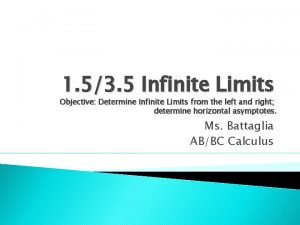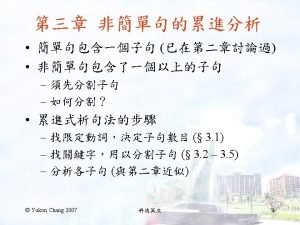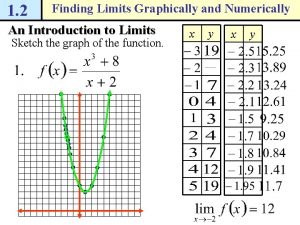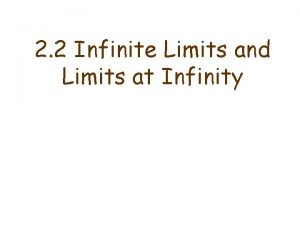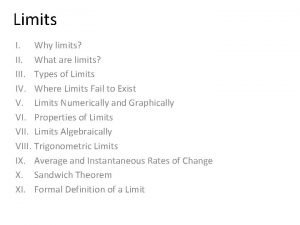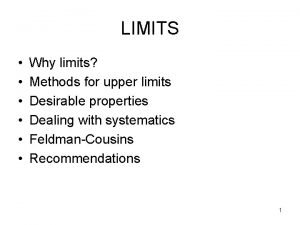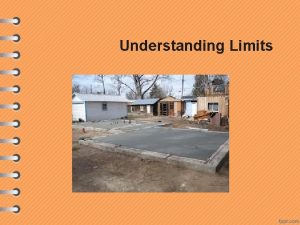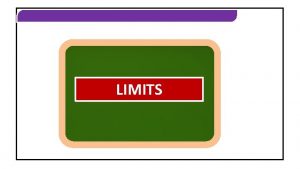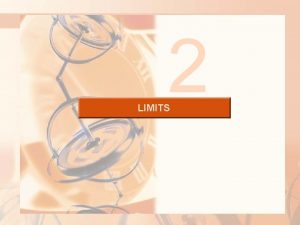Infinite Limits Lesson 1 5 Infinite Limits Two





















- Slides: 21

Infinite Limits Lesson 1. 5

Infinite Limits Two Types of infinite limits. Either the limit equals infinity or the limit is approaching infinity. We are going to take a look at when the limit equals infinity, for now.

1. 5 Infinite Limits • Vertical asymptotes at x = c will give you infinite limits • Take the limit at x = c and the behavior of the graph at x = c is a vertical asymptote then the limit is infinity • Really the limit does not exist, and that it fails to exist is b/c of the unbounded behavior (and we call it infinity)

The function f(x) will have a vertical asymptote at x = a if we obtain any of the following limits:

Definition of Infinite Limits f(x) increases without bound as x c NOTE: may decrease without bound ie: go to negative infinity!! M -------

Vertical Asymptotes • When f(x) approaches infinity as x → c – Note calculator often draws false asymptote • Vertical asymptotes generated by rational functions when g (x) = 0 c

Theorem 1. 14 Finding Vertical Asymptotes • If the denominator = 0 at x = c AND the numerator is NOT zero, we have a vertical asymptote at x = c!!!!!!! IMPORTANT • What happens when both num and den are BOTH Zero? !? !

A Rational Function with Common Factors (Should be x approaching 2) • When both numerator and denominator are both zero then we get an indeterminate form and we have to do something else … – Direct sub yields 0/0 or indeterminate form – We simplify to find vertical asymptotes but how do we solve the limit? When we simplify we still have indeterminate form.

A Rational Function with Common Factors, cont…. • Direct sub yields 0/0 or indeterminate form. When we simplify eliminate indeterminate form and we learn that there is a vertical asymptote at x = -2 by theorem 1. 14. • Take lim as x -2 from left and right • Take values close to – 2 from the right and values close to – 2 from the left … Table and you will see values go to positive or negative infinity

Determining Infinite Limits • Denominator = 0 when x = 1 AND the numerator is NOT zero – Thus, we have vertical asymptote at x=1 • But is the limit +infinity or –infinity? • Let x = small values close to c • Use your calculator to make sure – but they are not always your best friend!

Infinite Limits: As the denominator approaches zero, the value of the fraction gets very large. If the denominator is positive then the fraction is positive. If the denominator is negative then the fraction is negative. vertical asymptote at x=0.

Example 4: The denominator is positive in both cases, so the limit is the same.

Properties of Infinite Limits • Given Then • Sum/Difference • Product • Quotient

Find each limit, if it exists.

Find each limit, if it exists. One-sided limits will always exist! Very small negative #


This time we only care if the two sides come together—and where. Can’t do Direct Sub, need to go to our LAST resort… check the limits from each side.

3. Find any vertical asymptotes of

3. Find any vertical asymptotes of Discontinuous at x = 2 and -2. V. A. at x = -2

Try It Out • Find vertical asymptote • Find the limit • Determine the one sided limit

Methods • Visually: Graphing • Analytically: Make a table close to “a” • Substitution: Substitute “a” for x If Substitution leads to: 1) A number L, then L is the limit 4) 0/0, an indeterminant form, you must do more! 2) 0/k, then the limit is zero 3) k/0, then the limit is ±∞, or dne
 Limits involving infinity asymptotes
Limits involving infinity asymptotes Infinite diversity in infinite combinations
Infinite diversity in infinite combinations How to find horizontal asymptotes
How to find horizontal asymptotes Infinite limits examples
Infinite limits examples Histogram polygon graph
Histogram polygon graph There are only two things that are infinite
There are only two things that are infinite Mathgotserved
Mathgotserved Analyzing limits graphically
Analyzing limits graphically 12-1 estimating limits graphically
12-1 estimating limits graphically Limits of functions of two variables
Limits of functions of two variables Lesson outline lesson 3 describing circuits answers
Lesson outline lesson 3 describing circuits answers Kind of fault
Kind of fault Lesson outline lesson 2 aquatic ecosystems answer key
Lesson outline lesson 2 aquatic ecosystems answer key Macro teaching lesson plan
Macro teaching lesson plan Ihi l101
Ihi l101 Gift of chappals lesson plan
Gift of chappals lesson plan Lesson 1 your total health
Lesson 1 your total health Lesson outline lesson 3 answer key
Lesson outline lesson 3 answer key Sat vocabulary lesson 4
Sat vocabulary lesson 4 Physical properties lesson 2
Physical properties lesson 2 Lesson 1 thermal energy and the behavior of matter
Lesson 1 thermal energy and the behavior of matter Lesson outline lesson 1 climates of earth answers key
Lesson outline lesson 1 climates of earth answers key


